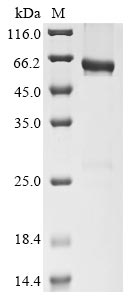Amino acids 22-321 constitute the expression domain of recombinant Human CD177. This CD177 protein is expected to have a theoretical molecular weight of 63.6 kDa. This protein is generated in a e.coli-based system. The CD177 gene fragment has been modified by fusing the N-terminal 6xHis-GST tag, providing convenience in detecting and purifying the recombinant CD177 protein during the following stages.
The human CD177 antigen is a glycoprotein expressed on the surface of neutrophils, a type of white blood cell involved in the immune response. CD177 is a member of the Ly-6 superfamily and contains a glycosylphosphatidylinositol (GPI) anchor that tethers it to the cell membrane. It plays a role in neutrophil adhesion and migration, interacting with other molecules in the immune system. CD177 expression can vary among individuals, and alterations in its levels have been associated with certain diseases, including vasculitis. Understanding the functions of CD177 contributes to the comprehension of neutrophil biology and immune responses in health and disease.




